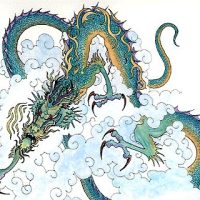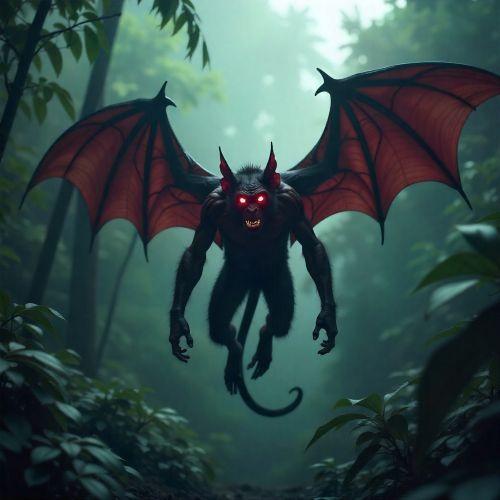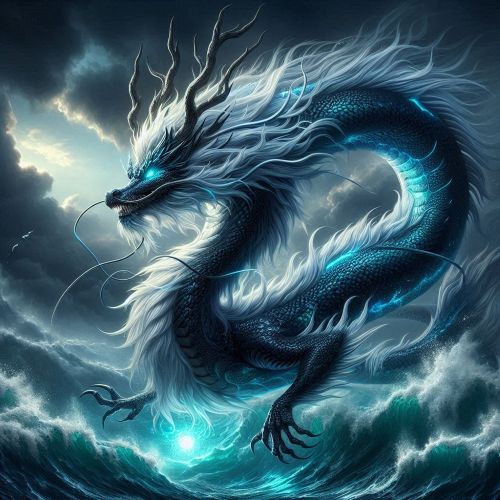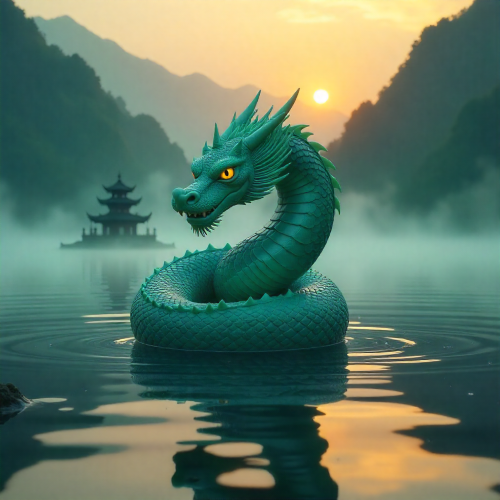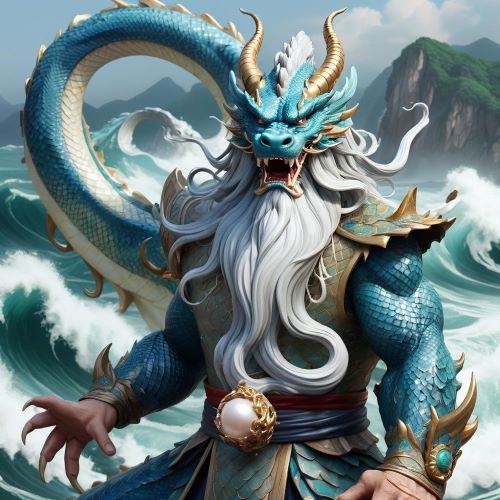Jiaolong : The Ancient Chinese Dragon of Rivers and Storms
Listen
At a glance
| Description | |
|---|---|
| Origin | Chinese Mythology |
| Classification | Animals |
| Family Members | N/A |
| Region | China |
| Associated With | Floods, Storms |
Jiaolong
Introduction
Jiaolong (蛟龙), often translated as the Flood Dragon or Scaled Dragon, is one of the most intriguing beings in Chinese mythology. Unlike the celestial dragons that bring rain and symbolize imperial power, the Jiaolong belongs to the untamed world of rivers, lakes, and stormy seas. It appears in texts such as the Shan Hai Jing and Sima Qian’s Records of the Grand Historian, where it is portrayed as a hornless aquatic dragon with enormous destructive potential. Ancient scholars frequently described it as a creature capable of whipping up storms, sweeping away villages, or guarding the thresholds between calm waters and catastrophic floods. For early Chinese societies that depended on seasonal river systems, the Jiaolong embodied both the blessings and dangers of water. This duality—nature’s generosity and its unpredictable violence—lies at the heart of the Jiaolong myth.
Physical Traits
The physical form of the Jiaolong sets it apart from the fully ascended forms of Chinese dragons. It is usually described as a long, scaled, serpentine creature with four limbs and a powerful tail adapted to aquatic movement. Its hornless head and elongated snout distinguish it from the majestic, antlered looks of celestial dragons. Some texts compare its body shape to crocodiles and giant river serpents, which has led scholars to suggest that real crocodile sightings, especially in southern China, may have informed its imagery. The Shuyi Ji describes it as an evolutionary stage in the dragon life cycle, formed when a large water serpent matures for centuries. Only after further transformation does a Jiaolong grow horns and wings, eventually joining the ranks of the true Long (龍). This transitional appearance, neither serpent nor complete dragon, reinforces its liminal status between myth and natural observation.
Family
Within the extensive taxonomy of Chinese dragons, the Jiaolong represents the early, imperfect, or developing state of dragonhood. Chinese mythology often views dragons as beings that evolve through stages, and Jiaolong stands as an intermediate phase—more powerful than simple water serpents but not yet worthy of heavenly ascension. It is often contrasted with dragons like Yinglong, the winged and rain-giving dragon associated with hero-kings, whose benevolent role differs sharply from the volatile nature of the Jiaolong. Although not counted among the traditional Nine Sons of the Dragon, the Jiaolong is frequently discussed in the same breath, especially when describing the diversity of dragon species. Its associations also extend to the cultures of southern China, particularly the Yue peoples, who were said to tattoo their bodies to protect themselves from Jiaolong attacks. These cultural links place Jiaolong within a broader mythic lineage shaped by regional ecological realities and local storytelling traditions.
Other names
The Jiaolong is known by several alternate names across historical sources and regional traditions. The character “蛟” alone is sometimes used to refer to the creature, often translated simply as “jiao.” It is regularly called the Flood Dragon, emphasizing its ability to swell rivers and unleash destructive waters. Some ancient Chinese dictionaries equate the Jiaolong with large river beasts described under names related to crocodiles, such as “guanpiluo,” reflecting the blurred boundaries between natural creatures and mythological interpretations. Regional folklore also refers to it as a river dragon or water dragon, highlighting its attachment to turbulent waterways. These varied names capture the creature’s shifting identity—part myth, part natural phenomenon, and part cultural symbol of power and danger.
Powers and Abilities
The powers of the Jiaolong revolve around its domination of water. It is believed to stir storms, generate whirlpools, and trigger floods, often emerging during periods of turbulent weather. Ancient accounts claim that its mere presence could cause rivers to overflow, and some legends warn that young Jiaolong emerging from eggs could unleash natural disasters. The creature is credited with immense strength, capable of overturning boats or dragging entire structures into the water. Several texts also associate the Jiaolong with transformative ability: after centuries of cultivation, it may ascend into a horned dragon able to fly, symbolizing mastery over both water and sky. This theme of metamorphosis echoes a broader Chinese concept—spiritual growth through perseverance. Yet, unlike benevolent dragons that support human civilization, the Jiaolong often represents nature’s chaos, reminding humanity of its vulnerability to powerful natural forces.
Modern Day Influence
The influence of the Jiaolong persists in contemporary culture, symbolism, and technology. China’s famous deep-sea submersible Jiaolong takes its name directly from the mythical creature, acknowledging both its aquatic associations and its ability to explore the unknown depths. The creature frequently appears in modern literature, animation, and video games, often portrayed as a fearsome aquatic guardian or a destructive flood entity. Artists continue to reinterpret the Jiaolong in visual media, drawing inspiration from classical depictions while giving it lifelike textures and serpentine motion. Its traditional symbolism also resonates with modern environmental discussions; the Jiaolong’s association with devastating floods parallels growing concerns about climate-related water disasters. In this way, the creature remains relevant—not just as a mythological being but as a reflection of humanity’s ongoing relationship with nature’s unpredictable power.
Related Images
Source
Wikipedia contributors. (2025). Jiaolong. In Wikipedia, The Free Encyclopedia. Retrieved November 22, 2025, from https://en.wikipedia.org/wiki/Jiaolong
StorytellingDB. (2025, October 30). Dragons of Chinese Mythology: Guardians of Celestial Forces. Retrieved from https://storytellingdb.com/dragon-chinese-mythology/
All About Dragons. Jiaolong. Retrieved from https://allaboutdragons.com/dragons/Jiaolong
China Market Advisor. (2025, February 5). How Chinese Folklore Influences Contemporary Culture and Media. Retrieved from https://chinamarketadvisor.com/how-chinese-folklore-influences-contemporary-culture-and-media/
Wikipedia contributors. (2025). Chinese dragon. In Wikipedia, The Free Encyclopedia. Retrieved November 22, 2025, from https://en.wikipedia.org/wiki/Chinese_dragon
Royal Lite Global. (2025, July 10). The Evolution of the Dragon in China: A Discourse. Retrieved from https://royalliteglobal.com/advanced-humanities/article/view/1872
Gods and Monsters. Jiaolong. Retrieved from https://godsandmonsters.info/jiaolong/
Age of Empires Series Wiki. (2025, September 16). Jiao-Long. Retrieved from https://ageofempires.fandom.com/wiki/Jiao-Long
Frequently Asked Questions
What is the Jiaolong in Chinese mythology?
The Jiaolong is a hornless flood dragon associated with rivers, lakes, and storms, known for its immense power over water.
Is the Jiaolong considered a true dragon?
In mythology, the Jiaolong is viewed as an intermediate stage; after centuries of cultivation it can transform into a full dragon.
What does the Jiaolong look like?
It is described as a long, scaled, serpent-like creature with four limbs, a crocodile-like snout, and no horns.
What powers does the Jiaolong have?
The Jiaolong can stir storms, cause floods, create whirlpools, and overpower boats or structures with its strength.
Why is China’s deep-sea submersible named Jiaolong?
It is named after the mythical creature to symbolize deep-water exploration and mastery over powerful aquatic environments.





